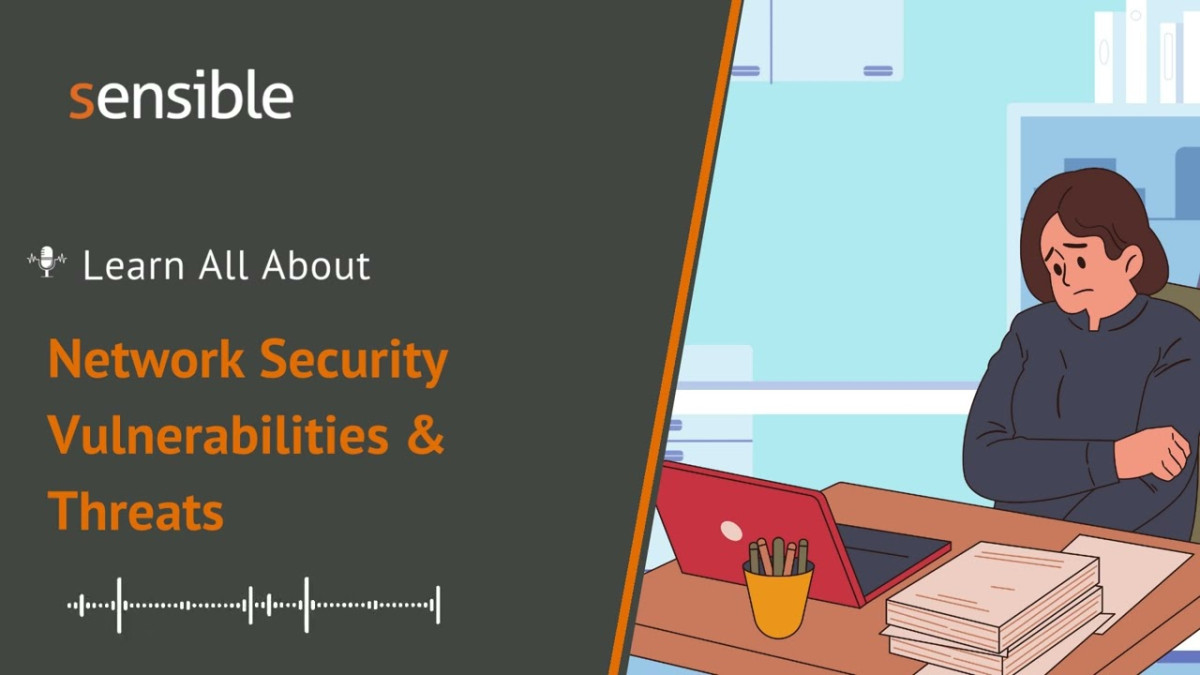Sydney IT Company Explains Key Network Security Risks and Strategies to Address Them
Norwest, Australia - January 17, 2025 / Sensible Business Solutions - Sydney Managed IT Services Company /
Stay Ahead of Network Security Threats with IT Company in Sydney
Network security vulnerabilities are weaknesses or flaws in a system that can be exploited. Comparatively, network security threats are the potential events or actions that can exploit these vulnerabilities. Please note that “threats” are not always insidious, they may be accidents or other events that no human caused.
| “The general assumption is that cyber security is best left to IT professionals. The truth is that cyber security is everyone’s responsibility. It’s only the complex technical tasks that should be left to the professionals.” - Ray Sweeney, Chief Commercial Officer, Sensible Business Solutions. |
Given this key difference, one’s approach to mitigating each needs to be different. You don’t need to be a technical expert to prevent cyber threats. There are some simple, everyday tasks that you can do to avoid leaving your network vulnerable.
To help you protect your confidential data, this article shared by an IT company in Sydney will explore some of those key tips. We’ll focus on what you and your non-technical employees can do to support your IT team’s cyber security efforts. We’ll also show you where you can find an IT team if you don’t have one.
6 Types of Vulnerabilities in Network Security & How to Minimise Them
- Outdated Software
As of 2022, exploiting software vulnerabilities in outdated systems surpassed credential theft as the top hacker tactic for gaining unauthorised access to networks. Reducing this vulnerability in your organisation is as easy as performing software updates whenever your system tells you that you need one.
This is because most updates include security patches that resolve potential entry points for cyber attacks.
- Weak Passwords
Telling people to use strong passwords to improve their security seems like overused advice. However, you may be surprised to learn that many “strong passwords” aren’t truly strong enough. Often, people who use weaker passwords are doing so because they don’t realise how weak their password is.
Firstly, passwords that use a mix of letters, numbers, and symbols are harder to crack. Avoiding obvious choices, like your name or "123456," is also an absolute requirement. Plus, it’s best practice to regularly change your passwords just in case someone is close to cracking it.
- Unpatched Systems
When software vendors discover vulnerabilities, they release patches to fix them. However, if your organisation fails to apply these patches, the vulnerabilities remain. Regularly check for and apply patches to all systems and applications to minimise this risk.
You’ll usually receive a notification for any critical updates (see point 1), but don’t take that for granted. It’s wise to double-check on your software vendor’s website or within the application itself to ensure no updates have been missed.
- Poor Access Control
Giving too many people too much access to your information opens you up to a whole host of cyber vulnerabilities. This can happen if there aren’t any clear rules about who can see what. The best approach is to make sure that each person can only access the information they need for their job.
- Open Ports
A port is a communication channel on your network that allows data to enter and exit. Some ports must stay open for your services to work, but leaving too many open can make it easier for hackers to get into your system. Regularly check for and close any ports that aren’t needed.
If you’re not technically inclined, you can start by using a simple port scanning tool, which is often available online. These tools can show you which ports are open on your network. Many routers also have settings where you can close ports directly.
- Lack of Encryption
A lack of encryption leaves data vulnerable to interception. Interception can occur as you transfer your data or while it sits in your storage systems. Encryption software is readily available to reduce interception risks. These tools scramble your data so that even if someone intercepts it, they can’t read it.
Use tools like VPNs (Virtual Private Networks) or enable HTTPS on websites, which automatically encrypt your information. For email and files, you can use encryption software such as BitLocker for Windows or FileVault for Mac.
6 Types of Network Security Threats & How to Prevent Them
- Malicious Software
Malicious software, or malware, includes viruses, worms, ransomware, and spyware that can harm your network. For the most part, following general cyber security best practices can help you reduce your risk of most malware infections.
A few more specific tips include the following.
| Tip | Explanation |
| Install and regularly update antivirus software | Antivirus software can detect and remove malicious software before it harms your system. |
| Use a firewall to block unauthorised access | A firewall monitors incoming and outgoing traffic and blocks suspicious activity. |
| Avoid downloading or opening files from unknown sources | Unknown files may contain malware that can compromise your network. |
| Regularly backup important data | Backups ensure that your data is safe even if your system is compromised. |
| Enable multi-factor authentication (MFA) where possible | MFA adds an extra layer of security by requiring a second form of verification. |
- Human Error
The simple truth is that 95% of security breaches are born from basic human error. Error may include downloading a malicious attachment or giving away information that shouldn’t have been disclosed. However, it may also include uneducated adjustments to your system settings.
This is part of why it’s so important to be discrete about who has access to what. Cyber awareness education is valuable, but limiting access to sensitive information will protect that data even more. Also, instruct employees to not adjust system settings unless they’ve been told to do so.
- Software Glitches
A system glitch may cause more information to be more easy to access than you want. These issues can occur without direct human involvement. For example, a software bug could turn off security settings. To reduce the risk, turn on automatic updates for your software, run regular security checks, and keep an eye on your system for anything unusual.
- Phishing Scams
Despite the amount of stories you hear about the dangers of suspicious emails, CloudSecureTech notes that 25% of workers have a habit of clicking almost every link they receive via email or social media. Additionally, 90% of people feel confident they could recognise a phishing email, yet only 5% actually pass a phishing test.
Prevent phishing by educating employees on how to spot phishing emails and by using email filtering tools to block suspicious messages. Threat actors are increasingly sophisticated in their tactics, so take tricker attempts into account.
A phishing email might look like it’s from a trusted source, so encourage people always to double-check the sender’s email address and be cautious of any urgent requests for personal information. If a specific person is named, ask that person directly before responding.
- DDoS Attacks
Distributed-Denial-of-Service (DDoS) attacks overwhelm your network with traffic, causing it to crash or become inaccessible to legitimate users. Attackers often do this simply to cause mischief. In some cases, it may also be used as a distraction to cover up other malicious activities happening simultaneously.
Prevent DDoS attacks by limiting who can access your network. For example, you can use a strong, unique password for your Wi-Fi and avoid sharing it with people who don’t need access. Also, restart your router regularly to clear any potential issues.
- Man-in-the-Middle Attacks
Man-in-the-Middle (MitM) attacks occur when an attacker intercepts communication between two parties to steal or manipulate data. Unpatched software and unencrypted data are most at risk of these types of attacks in network security.
One of the best, and easiest, ways to avoid MitM attacks is to avoid using public Wi-Fi for work. If you’re in a situation where you have no other choice, use a VPN. Public Wi-Fi is risky because it often doesn’t use the same level of security you’d expect for your business network.
Enhance Your Cybersecurity with Expert Assistance from a Leading Sydney IT Firm
There’s a lot you can do on your own to reduce your risk of many common network vulnerabilities. However, these measures can only take you so far. Advanced protection is often needed to mitigate more complex information security vulnerabilities.
If you can’t do it on your own, Sensible Business Solutions can help. We’re cyber experts who can perform regular vulnerability scanning and patch any issues we find. We’ll work constantly to keep you secure. If there’s a problem, we’ll resolve it before you even notice anything was ever amiss.
Reach out to the most trusted Sydney IT firm today to learn more about how we can help.

Contact Information:
Sensible Business Solutions - Sydney Managed IT Services Company
Suite 8, Level 1, Block A/38 Brookhollow Ave
Norwest, NSW 2153
Australia
Sensible Business Solutions
+61 3 0073 6742
https://sensible.com.au/managed-it-services-sydney/
Original Source: https://sensible.com.au/business-value/network-security-threats-and-vulnerabilities/


